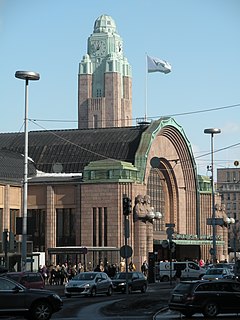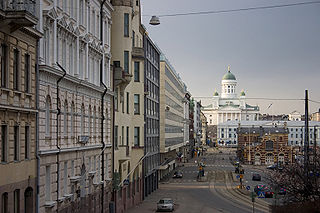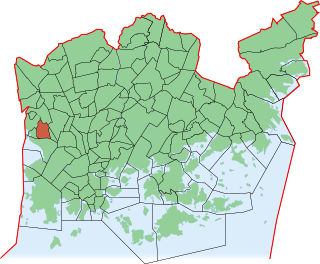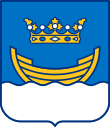
Helsinki is the capital, primate, and most populous city of Finland. Located on the shore of the Gulf of Finland, it is the seat of the region of Uusimaa in southern Finland, and has a population of 658,864. The city's urban area has a population of 1,268,296, making it by far the most populous urban area in Finland as well as the country's most important center for politics, education, finance, culture, and research; while Tampere in the Pirkanmaa region, located 179 kilometres (111 mi) to the north from Helsinki, is the second largest urban area in Finland. Helsinki is located 80 kilometres (50 mi) north of Tallinn, Estonia, 400 km (250 mi) east of Stockholm, Sweden, and 300 km (190 mi) west of Saint Petersburg, Russia. It has close historical ties with these three cities.

Helsinki Central Station (HEC) is the main station for commuter rail and long-distance trains departing from Helsinki, Finland. The station is used by approximately 400,000 people per day, of which about 200,000 are passengers. It serves as the terminus for all trains in the Helsinki commuter rail network, as well as for all Helsinki-bound long-distance trains in Finland. The Rautatientori metro station is located in the same building.

Aleksanterinkatu is a street in Kluuvi, the commercial centre of Helsinki, Finland. In the city plan by Carl Ludvig Engel, it was the Decumanus Maximus, the main east–west street in the city, crossing the Cardo, Unioninkatu (Union Street) at the corner of the Senate Square.

Esplanadi, colloquially known as Espa, is an esplanade and urban park in downtown Helsinki, Finland, situated between the Erottaja square and the Market Square. It is bordered on its northern and southern sides by the Pohjoisesplanadi and Eteläesplanadi streets, respectively. Aleksanterinkatu runs parallel to Esplanadi. Esplanadi is well known as a popular walking area, and street performances are also often held in the park.

Klaukkala is a large town-like village in the southern part of the Nurmijärvi municipality of Uusimaa, Finland, near Lake Valkjärvi. It is the largest of the villages in Nurmijärvi and often mistakenly thought to be a separate town. In the 2010s, Klaukkala's urban area grew to be part of the Helsinki urban area.

The Three Smiths Statue is a sculpture by Felix Nylund, situated in Helsinki, Finland, in Three Smiths Square at the intersection of Aleksanterinkatu and Mannerheimintie. This realistic statue, unveiled in 1932, depicts three naked smiths hammering on an anvil.

Kluuvi is the commercial centre of Helsinki, Finland, and a neighbourhood in the Vironniemi district of Helsinki. The Helsinki Central railway station, Hotel Kämp and Hotel Arthur, the Helsinki main post office, the Stockmann and Sokos department stores, the Kluuvi shopping centre and the main offices of Finnish banks are located in Kluuvi. Kluuvi includes the central campus of the University of Helsinki, the Ateneum art museum, and the movie theatres Maxim, Kinopalatsi and Bristol. The northeastern part of Kluuvi, which includes the Kaisaniemi park, is commonly called Kaisaniemi, but it is not the official name of any neighbourhood in Helsinki.

Stockmann Helsinki Centre is a culturally significant business building and department store located in the centre of Helsinki, Finland. It is one of many department stores owned by the Stockmann corporation. It is the largest department store in the Nordic countries in terms of area and total sales. The store is known for carrying all the internationally recognised luxury brands, and Stockmann's enjoys a reputation as the primary high-end department store in Finland. Stockmann Delicatessen, the food and beverage department located at the basement level, is renowned for the quality and choice of its foodstuffs. The Stockmann logo represents a set of escalators, which are commonly, but wrongly believed represent the first escalators in Finland. The first escalators in Finland were installed in the Forum department store, Turku (1926).

Kaartinkaupunki is a neighbourhood in the southern part of Helsinki, Finland.

Munkkivuori is a quarter of the Munkkiniemi neighbourhood in Helsinki. The buildings and the plan of site are typical of the late 1950s. Most of the residential buildings in Munkkivuori are within a loop formed by Ulvilantie ring road. The automotive traffic to the residential buildings is routed along Ulvilantie whereas Raumantie no through road terminating in the center of the Ulvilantie loop provides access to public services and limits the through-traffic in residential areas. A designed network of crushed stone walkways provides easy accessibility around Munkkivuori for cyclists, pedestrians and other non-automotive traffic.

The Old Student House is the former student house of the Student Union of the University of Helsinki, located in central Helsinki, Finland, near the crossing of Aleksanterinkatu and Mannerheimintie.

Redi is a shopping centre in Kalasatama, Helsinki, Finland. With its gross leasable area of 64,000 square metres (690,000 sq ft), it is the eighth largest shopping centre in Finland.

Hotel Marski is a hotel opened 1962 on Mannerheimintie 10 in Helsinki, Finland.

Domus Litonii is a three-story Empire style residential, commercial and office building with a lower bazaar wing located at Aleksanterinkatu 50 in central Helsinki, Finland.

Keskuskatu, meaning "central street", is a two block long walking street in the centre of Helsinki, Finland. Along the street are located, counting from the southern end on Pohjoisesplanadi street, the Stockmann department store, the Rautatalo building, Domus Litonii, WTC Helsinki and the shopping centre City-Center, nicknamed "Makkaratalo". Keskuskatu ends at Kaivokatu opposite to the Helsinki Central railway station. Halfway through the street it is crossed by Aleksanterinkatu.
The Eino Leino is a statue of Eino Leino (1878–1926) sculpted by Lauri Leppänen in the Esplanadi Park in Helsinki, Finland. It is located in the northeast corner of Teatteriesplanadi, close to the intersection of the Pohjoisesplanadi and Mikonkatu streets.

Karl August Wrede was a Finnish-Swedish architect. His buildings are mostly in the Neo-Renaissance and Neo-Gothic styles.

The Lundqvist Building is a former department store in the Kluuvi district of central Helsinki, Finland. It is located at the intersection of Aleksanterinkatu and Mikonkatu streets. Until the end of 2020, it housed the Aleksi 13 department store, but is now the home of Glasshouse Helsinki, a boutique for ecologically-minded fashion. Its architecture represents a transition from the revivalism of the nineteenth century to Art Nouveau and advanced construction techniques at the dawn of the twentieth.

Mikonkatu is a street in central Helsinki, Finland, leading north from the Esplanadi Park to the Kaisaniemi Park, mostly converted into a pedestrian street in 1992.

Kappeli, also known as Esplanadikappeli, is a restaurant in central Helsinki, Finland at the eastern end of the Esplanadi park, opened in 1867. The restaurant was known as a local favourite among poets, writers and artists during the late 19th and early 20th centuries. In August 2020 the building changed ownership from the city of Helsinki to HOK-Elanto, who currently also owns the restaurant itself.






















